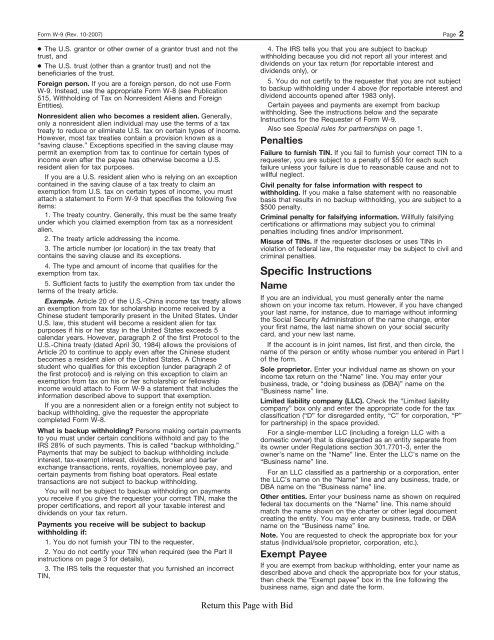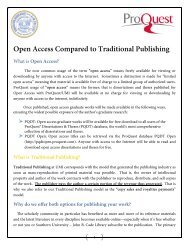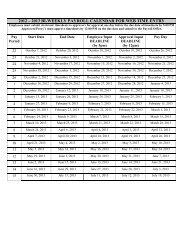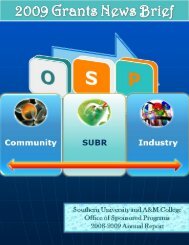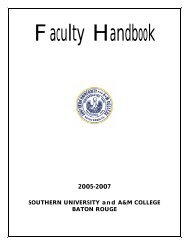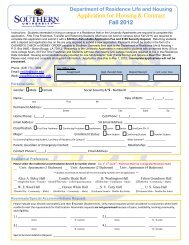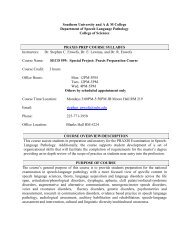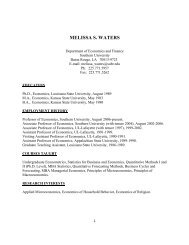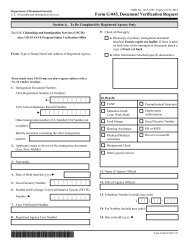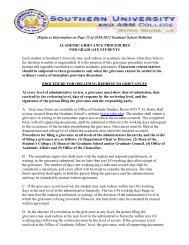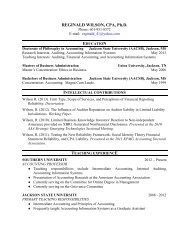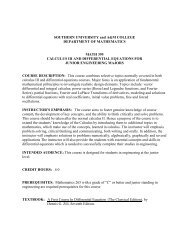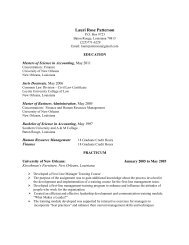Form W-9 (Rev. October 2007)
Form W-9 (Rev. October 2007)
Form W-9 (Rev. October 2007)
You also want an ePaper? Increase the reach of your titles
YUMPU automatically turns print PDFs into web optimized ePapers that Google loves.
<strong>Form</strong> W-9 (<strong>Rev</strong>. 10-<strong>2007</strong>) Page 2<br />
● The U.S. grantor or other owner of a grantor trust and not the<br />
trust, and<br />
● The U.S. trust (other than a grantor trust) and not the<br />
beneficiaries of the trust.<br />
Foreign person. If you are a foreign person, do not use <strong>Form</strong><br />
W-9. Instead, use the appropriate <strong>Form</strong> W-8 (see Publication<br />
515, Withholding of Tax on Nonresident Aliens and Foreign<br />
Entities).<br />
Nonresident alien who becomes a resident alien. Generally,<br />
only a nonresident alien individual may use the terms of a tax<br />
treaty to reduce or eliminate U.S. tax on certain types of income.<br />
However, most tax treaties contain a provision known as a<br />
“saving clause.” Exceptions specified in the saving clause may<br />
permit an exemption from tax to continue for certain types of<br />
income even after the payee has otherwise become a U.S.<br />
resident alien for tax purposes.<br />
If you are a U.S. resident alien who is relying on an exception<br />
contained in the saving clause of a tax treaty to claim an<br />
exemption from U.S. tax on certain types of income, you must<br />
attach a statement to <strong>Form</strong> W-9 that specifies the following five<br />
items:<br />
1. The treaty country. Generally, this must be the same treaty<br />
under which you claimed exemption from tax as a nonresident<br />
alien.<br />
2. The treaty article addressing the income.<br />
3. The article number (or location) in the tax treaty that<br />
contains the saving clause and its exceptions.<br />
4. The type and amount of income that qualifies for the<br />
exemption from tax.<br />
5. Sufficient facts to justify the exemption from tax under the<br />
terms of the treaty article.<br />
Example. Article 20 of the U.S.-China income tax treaty allows<br />
an exemption from tax for scholarship income received by a<br />
Chinese student temporarily present in the United States. Under<br />
U.S. law, this student will become a resident alien for tax<br />
purposes if his or her stay in the United States exceeds 5<br />
calendar years. However, paragraph 2 of the first Protocol to the<br />
U.S.-China treaty (dated April 30, 1984) allows the provisions of<br />
Article 20 to continue to apply even after the Chinese student<br />
becomes a resident alien of the United States. A Chinese<br />
student who qualifies for this exception (under paragraph 2 of<br />
the first protocol) and is relying on this exception to claim an<br />
exemption from tax on his or her scholarship or fellowship<br />
income would attach to <strong>Form</strong> W-9 a statement that includes the<br />
information described above to support that exemption.<br />
If you are a nonresident alien or a foreign entity not subject to<br />
backup withholding, give the requester the appropriate<br />
completed <strong>Form</strong> W-8.<br />
What is backup withholding? Persons making certain payments<br />
to you must under certain conditions withhold and pay to the<br />
IRS 28% of such payments. This is called “backup withholding.”<br />
Payments that may be subject to backup withholding include<br />
interest, tax-exempt interest, dividends, broker and barter<br />
exchange transactions, rents, royalties, nonemployee pay, and<br />
certain payments from fishing boat operators. Real estate<br />
transactions are not subject to backup withholding.<br />
You will not be subject to backup withholding on payments<br />
you receive if you give the requester your correct TIN, make the<br />
proper certifications, and report all your taxable interest and<br />
dividends on your tax return.<br />
Payments you receive will be subject to backup<br />
withholding if:<br />
1. You do not furnish your TIN to the requester,<br />
2. You do not certify your TIN when required (see the Part II<br />
instructions on page 3 for details),<br />
3. The IRS tells the requester that you furnished an incorrect<br />
TIN,<br />
4. The IRS tells you that you are subject to backup<br />
withholding because you did not report all your interest and<br />
dividends on your tax return (for reportable interest and<br />
dividends only), or<br />
5. You do not certify to the requester that you are not subject<br />
to backup withholding under 4 above (for reportable interest and<br />
dividend accounts opened after 1983 only).<br />
Certain payees and payments are exempt from backup<br />
withholding. See the instructions below and the separate<br />
Instructions for the Requester of <strong>Form</strong> W-9.<br />
Also see Special rules for partnerships on page 1.<br />
Penalties<br />
Failure to furnish TIN. If you fail to furnish your correct TIN to a<br />
requester, you are subject to a penalty of $50 for each such<br />
failure unless your failure is due to reasonable cause and not to<br />
willful neglect.<br />
Civil penalty for false information with respect to<br />
withholding. If you make a false statement with no reasonable<br />
basis that results in no backup withholding, you are subject to a<br />
$500 penalty.<br />
Criminal penalty for falsifying information. Willfully falsifying<br />
certifications or affirmations may subject you to criminal<br />
penalties including fines and/or imprisonment.<br />
Misuse of TINs. If the requester discloses or uses TINs in<br />
violation of federal law, the requester may be subject to civil and<br />
criminal penalties.<br />
Specific Instructions<br />
Name<br />
If you are an individual, you must generally enter the name<br />
shown on your income tax return. However, if you have changed<br />
your last name, for instance, due to marriage without informing<br />
the Social Security Administration of the name change, enter<br />
your first name, the last name shown on your social security<br />
card, and your new last name.<br />
If the account is in joint names, list first, and then circle, the<br />
name of the person or entity whose number you entered in Part I<br />
of the form.<br />
Sole proprietor. Enter your individual name as shown on your<br />
income tax return on the “Name” line. You may enter your<br />
business, trade, or “doing business as (DBA)” name on the<br />
“Business name” line.<br />
Limited liability company (LLC). Check the “Limited liability<br />
company” box only and enter the appropriate code for the tax<br />
classification (“D” for disregarded entity, “C” for corporation, “P”<br />
for partnership) in the space provided.<br />
For a single-member LLC (including a foreign LLC with a<br />
domestic owner) that is disregarded as an entity separate from<br />
its owner under Regulations section 301.7701-3, enter the<br />
owner’s name on the “Name” line. Enter the LLC’s name on the<br />
“Business name” line.<br />
For an LLC classified as a partnership or a corporation, enter<br />
the LLC’s name on the “Name” line and any business, trade, or<br />
DBA name on the “Business name” line.<br />
Other entities. Enter your business name as shown on required<br />
federal tax documents on the “Name” line. This name should<br />
match the name shown on the charter or other legal document<br />
creating the entity. You may enter any business, trade, or DBA<br />
name on the “Business name” line.<br />
Note. You are requested to check the appropriate box for your<br />
status (individual/sole proprietor, corporation, etc.).<br />
Exempt Payee<br />
If you are exempt from backup withholding, enter your name as<br />
described above and check the appropriate box for your status,<br />
then check the “Exempt payee” box in the line following the<br />
business name, sign and date the form.<br />
Return this Page with Bid


